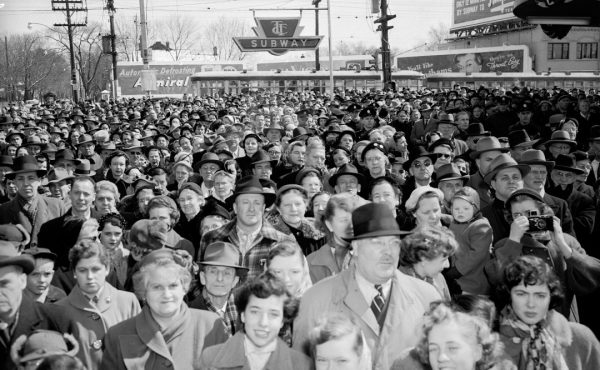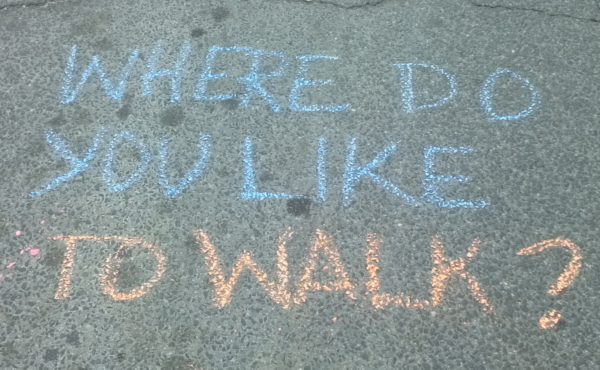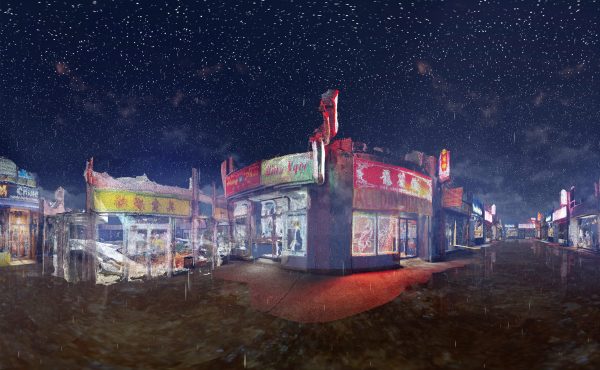Google maps a long-demolished hospital and a rather strange landmark.
I found myself aimlessly browsing through Google Maps lately. They’ve done a nice job recently adding street addresses and updating the street network on the base map layer. The subway station locations of which some were comically misplaced (Wilson Station at Wilson and Keele) have been fixed as well, with a few exceptions Downsview Station appears to be located at the Wilson subway yards, and Summerhill Station is shown at Summerhill Avenue, and not at Shaftsbury, where the entrance is.
Additionally, the good people at Google took it upon themselves to add local landmarks. This is where things seem to get very curious.
Many of the most famous points of interest have been added to the maps, including City Hall, CN Tower, Massey Hall, Eaton Centre, the ROM and the AGO, and each of the main bank towers.
Among these giants, are much more local downtown landmarks: El Mocambo, Horseshoe Tavern, Brunswick House, Keg Mansion, Bistro 990, and the Orbit Room. Lee’s Palace is there too, but seems to be where the Bloor Cinema is located. Perhaps the editors wanted to focus on arts, entertainment and live music venues, but it seems strange to add an upscale Bay Street restaurant and a steakhouse to the mix. Making things stranger are what’s conspicuously absent, including the St. Lawrence Centre and the Royal Alex and Princess of Wales Theatres. The Drake Hotel is mapped, but not the Gladstone.
Even stranger are what places of worship are included, and which ones are excluded. The Toronto Chinese Baptist Church on Beverley is there as well as Holy Blossom Temple on Bathurst, and Deer Park and Timothy Eaton United Churches, but not the historic downtown cathedrals of St. James or St. Michael’s. Only an elite selection of high schools are mapped as well, including University of Toronto Schools, Havergal College and Northern Secondary. Upper Canada College doesn’t make the cut, apparently.
I just can’t figure it out, as there’s no rhyme or reason to what’s included or what’s not. I thought that, in jest, that it might have been the work of west-end hipsters, as Sneaky Dee’s is there, but then again, there’s no sign of that infamous “dive bar”, The Communist’s Daughter. My best guess is that this might have been the result of a mental map exercise by first-year University of Toronto geography students. Can you figure it out?




18 comments
They also have “Bloor (University to Yonge) &” in the block bordered by York, Richmond, Bay, and Adelaide. Interesting.
I decided to look for some anomalies myself and I found one alright:
The Ontario Legislative Building isn’t even labeled, but Whitney Block is!
Also missing: Old City Hall
Maybe google is acknowledging the power of the bureaucracy vs the legislature?
I’ve noticed the same thing. I’ve contacted google about this, and they blame outsourcing. They use NAVTEQ
(http://mapreporter.navteq.com/) and TeleAtlas (http://www.teleatlas.com/MapInsight/). When there is an error, Google suggests contacting these two.
Hope this helps.
A look at the satellite layer of the south side of Bloor just west of Queen’s Park Boulevard reveals that the demolition has just begun on the ROM, but the construction has not yet begun on the RCM next door.
This dates the satellite photo at around December 2004 (since RCM construction began in January 2005). Can’t Google Maps use a more recent photo of downtown Toronto?
Chris: What I didn’t mention, is that Live Search Maps, the Microsoft competitor, seems to have more recent satellite images. The “bird’s eye” view is different, and seems to date from summer of 2007 and is really neat as well, but the satellite imagery isn’t as extensive as Google’s which has most of urbanized Ontario now, and a lot of rural areas in high-res. Google’s images in the suburbs seem to be more up-to-date though.
I have no idea where they got this, but they’re calling Cabbagetown “Parliament Corridor (Wellesley to Gerrard)”.
You can usually confirm Google’s air photo date in Google Earth — it shows up at the bottom of the screen. (Sometimes accurate to the day, sometimes only to the year.)
Just to throw another into the mix: the city has its own Toronto Maps applet that I’m pretty sure predates Google Maps. Their default aerial view is dated “2005” and looks to be the same as Google’s. But (and I don’t remember seeing this before) they also let you choose aerial views from 2003, 2002, and 1999. In some areas, the change over those six years is pretty dramatic.
Love to hear all discussion about Geo-Located data. Would love some feedback on my startup: http://www.homezilla.ca/.
We are adding new data everyday and hopefully we have all the subway stations located correctly.
Since Matt L. brings it up, a lot of southern Ontario municipalities have mapping applications on their web sites. Most have air photos and other features that may be of interest, including property lines and building outlines. Toronto’s also maps laneways, which is an interesting and useful feature.
Mississauga’s mapping features includes air photos, and they have multiple dates going back to at least the 1950s (!!) which provides for a striking view at how suburbia has transformed the landscape west of Toronto, not to mention how infrastructure has changed since then (e.g. compare the QEW and 401 back in the 1950s and 1960s).
I just noticed that Google Maps has added a transit trip directions option – something that should have been done ages ago. Montreal is one of the cities with the option, as is Fredericton, NB and Missoula, Montana. And yet, it’s not available for Toronto. Hmmm, why could that be?
http://www.google.ca/transit
See openstreetmap.org for a user-created map which includes Toronto. It’s not finished yet, but most of the downtown area is finished as are some of the surrounding areas.
Regarding the abundance of parks and places of worship – I’d consider the fact that TeleAtlas is a European company when examining what points of interest they choose to include.
Since Google’s switchover from NAVTEQ to TeleAtlas, North American data has been a bit of a trainwreck. Try panning and zooming to Iqaluit (or any smaller settlements, regardless of provincial/territorial capital status) – they won’t appear until you’re at a very large scale. There is approximately thirty year old data still appearing in Toronto. Entire subdivisions that haven’t been built yet are already appearing via TeleAtlas, yet existing subdivisions are missing. Labels cut off randomly (check Toronto Western Hospital). Overpass data often has the wrong street on top. Many small businesses that developed custom Google Maps for their websites found their maps rendered useless after the switchover. I’m stickin’ to Virtual Earth for their NAVTEQ data when I need web-based maps.
You can compare simultaneous views of Virtual Earth and Google Maps here: http://www.jonasson.org/maps
Beyond questions of correct data, their non-inclusion of important features (e.g. settlement labels) until certain extremely large scales is the biggest flaw in my eyes. My current research involves the mapping of remote settlements in far Northern Ontario – the one-time convenience Google Maps/Earth is pretty useless to me now.
oops – the one-time convenience *of* Google Maps/Earth is pretty useless to me now.
try this kml on Google Earth:
http://addyourpoint.com/points_kml.php
its realy cool!!!
tele atlas is a european company that’s good at euro stuff it the same can’t be said about their north american data. they mapped most of canada with their specialized mapping vans but the people producing the info are not canadian so simple local knowledge sometimes is severely lacking. also a city like toronto is constantly changing and needs to be updated and I don’t think tele atlas has sufficient staff.